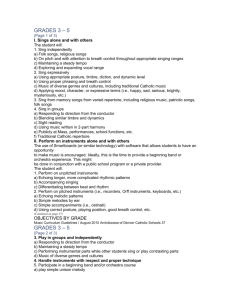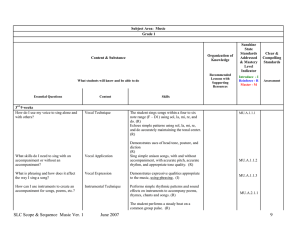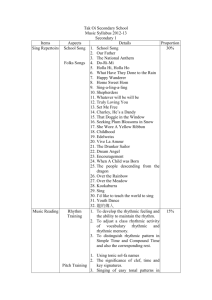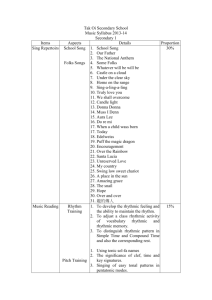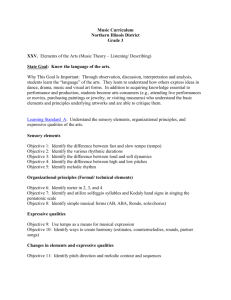Discovering Pitch, Melody, and Tone Color
advertisement
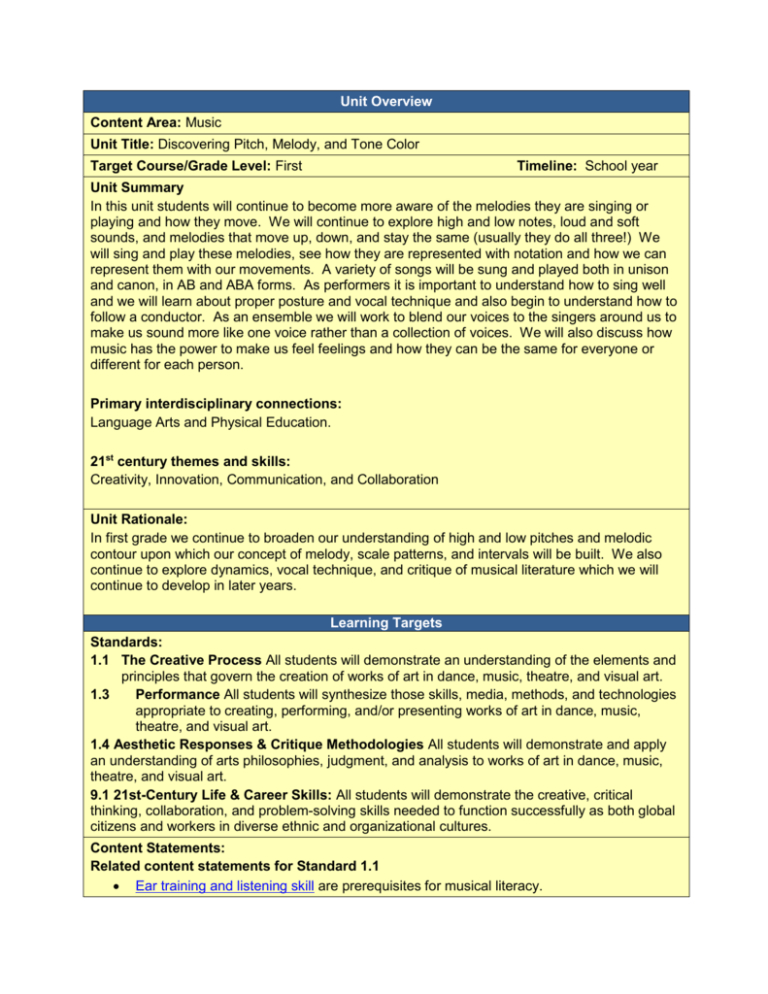
Unit Overview Content Area: Music Unit Title: Discovering Pitch, Melody, and Tone Color Target Course/Grade Level: First Timeline: School year Unit Summary In this unit students will continue to become more aware of the melodies they are singing or playing and how they move. We will continue to explore high and low notes, loud and soft sounds, and melodies that move up, down, and stay the same (usually they do all three!) We will sing and play these melodies, see how they are represented with notation and how we can represent them with our movements. A variety of songs will be sung and played both in unison and canon, in AB and ABA forms. As performers it is important to understand how to sing well and we will learn about proper posture and vocal technique and also begin to understand how to follow a conductor. As an ensemble we will work to blend our voices to the singers around us to make us sound more like one voice rather than a collection of voices. We will also discuss how music has the power to make us feel feelings and how they can be the same for everyone or different for each person. Primary interdisciplinary connections: Language Arts and Physical Education. 21st century themes and skills: Creativity, Innovation, Communication, and Collaboration Unit Rationale: In first grade we continue to broaden our understanding of high and low pitches and melodic contour upon which our concept of melody, scale patterns, and intervals will be built. We also continue to explore dynamics, vocal technique, and critique of musical literature which we will continue to develop in later years. Learning Targets Standards: 1.1 The Creative Process All students will demonstrate an understanding of the elements and principles that govern the creation of works of art in dance, music, theatre, and visual art. 1.3 Performance All students will synthesize those skills, media, methods, and technologies appropriate to creating, performing, and/or presenting works of art in dance, music, theatre, and visual art. 1.4 Aesthetic Responses & Critique Methodologies All students will demonstrate and apply an understanding of arts philosophies, judgment, and analysis to works of art in dance, music, theatre, and visual art. 9.1 21st-Century Life & Career Skills: All students will demonstrate the creative, critical thinking, collaboration, and problem-solving skills needed to function successfully as both global citizens and workers in diverse ethnic and organizational cultures. Content Statements: Related content statements for Standard 1.1 Ear training and listening skill are prerequisites for musical literacy. The elements of music are foundational to basic music literacy. Music is often defined as organized sound that is dependent on predictable properties of tone and pitch. Musical notation captures tonality, dynamic range, and rhythm. Musical instruments have unique qualities of tonality and resonance. Conventional instruments are divided into musical families according to shared properties. Related content statements for Standard 1.3 Creating and performing music provides a means of self-expression for very young learners. The ability to read music notation correlates with musical fluency and literacy. Notation systems are complex symbolic languages that indicate pitch, rhythm, dynamics, and tempo. Proper vocal production/vocal placement requires an understanding of basic anatomy and the physical properties of sound. Playing techniques for Orff instruments develop foundational skills used for hand percussion and melodic percussion instruments. Proper breathing technique and correct posture improve the timbre of the voice and protect the voice when singing. Prescribed forms and rules govern music composition, rhythmic accompaniment, and the harmonizing of parts. Basic conducting patterns and gestures provide cues about how and when to execute changes in dynamics, timbre, and timing. Related content statements for Standard 1.4A Each arts discipline offers distinct opportunities to observe, experience, interpret, appreciate, and respond to works of art and beauty in the everyday world. Related content statements for Standard 9.1A The ability to recognize a problem and apply critical thinking and problem-solving skills to solve the problem is a lifelong skill that develops over time. Related content statements for Standard 9.1B Brainstorming activities enhance creative and innovative thinking in individual and group goal setting and problem solving. CPI # 1.1.2.B.1 1.1.2.B.2 1.1.2.B.3 1.1.2.B.4 1.3.P.B.1 1.3.P.B.2 1.3.P.B.3 1.3.P.B.4 1.3.P.B.6 Cumulative Progress Indicator (CPI) Explore the elements of music through verbal and written responses to diverse aural prompts and printed scores. Identify musical elements in response to diverse aural prompts, such as rhythm, timbre, dynamics, form, and melody. Identify and categorize sound sources by common traits (e.g., scales, rhythmic patterns, and/or other musical elements), and identify rhythmic notation up to eighth notes and rests. Categorize families of instruments and identify their associated musical properties. Sing a variety of songs with expression, independently and with others. Use a variety of musical instruments to create music, alone and/or with others, using different beats, tempos, dynamics, and interpretations. Clap or sing songs with repetitive phrases and rhythmic patterns. Listen to, imitate, and improvise sounds, patterns, or songs. Recognize and name a variety of music elements using appropriate music 1.3.2.B.1 1.3.2.B.2 1.3.2.B.3 1.3.2.B.4 1.3.2.B.6 1.3.2.B.7 1.4.P.A.6 9.1.4.A.1 9.1.4.A.5 9.1.4.B.1 vocabulary. Clap, sing, or play on pitch from basic notation in the treble clef, with consideration of pitch, rhythm, dynamics, and tempo. Demonstrate developmentally appropriate vocal production/vocal placement and breathing technique. Demonstrate correct playing techniques for Orff instruments or equivalent homemade instruments. Vocalize the home tone of familiar and unfamiliar songs, and demonstrate appropriate posture and breathing technique while performing songs, rounds, or canons in unison and with a partner. Sing or play simple melodies or rhythmic accompaniments in AB and ABA forms independently and in groups, and sight-read rhythmic and music notation up to and including eighth notes and rests in a major scale. Blend unison and harmonic parts and vocal or instrumental timbres while matching dynamic levels in response to a conductor’s cues. Begin to demonstrate appropriate audience skills during recordings and music performances. Recognize a problem and brainstorm ways to solve the problem individually or collaboratively. Apply critical thinking and problem-solving skills in classroom and family settings. Participate in brainstorming sessions to seek information, ideas, and strategies that foster creative thinking. Unit Essential Questions Unit Enduring Understandings What do sol, mi, la, do, and re look and Songs can be sung in unison or in harmony. sound like? Melodies can have an accompaniment or no How does melodic movement affect the way accompaniment. music sounds? Symbols can be used to represent sol, mi, la, How do dynamics and temp affect the way a do, and re. piece of music sounds or makes us feel? We can hear the way a melody moves and represent it with movement. Unit Learning Targets Students will ... Perform simultaneous imitation using movement, instruments, and vocal sounds. Distinguish louder from softer dynamics. Explore speech material for inflection, improvisation, and rhythm. Distinguish higher from lower pitches. Echo-sing melodic motives. Show the direction of a melody with body movement. Imitate then improvise melodies vocally and on Orff instruments. Sing, play, and listen to music in AB and ABA form. Sing songs and canons with proper breathing and technique while blending with the singers around them. Recognize and vocalize the home tone (do) of familiar and unfamiliar songs. Imitate melodies vocally and on instruments using sol, mi, la, do, and re. Play aural recognition games using sol, mi, la, do, and re. Evidence of Learning Summative Assessment Pre-assessment, participation, performance and observation, self and group assessment, question and answer, classroom discussion, and games. Equipment needed: Folksong CD’s, piano or keyboard, rhythm sticks, various hand percussion instruments, poly spots, mallet percussion instruments, various supplemental materials, books, and music. Teacher Instructional Resources: Music Express Subscription Music K-8 Subscription Tempo Magazine Kodaly in the Classroom by Linda Rann Discovering Orff by Jane Franzee Orff-Schulwerk Applications for the Classroom by Brigitte Warner Formative Assessments Self and group assessment and concerts. Integration of Technology: Smart Board Technology Resources: Click the links below to access additional resources used to design this unit: www.classicsforkids.com www.musick8.com www.menc.org www.acda.org www.sfskids.org Opportunities for Differentiation: Differentiate by student need, interest and readiness level. Teacher Notes:


